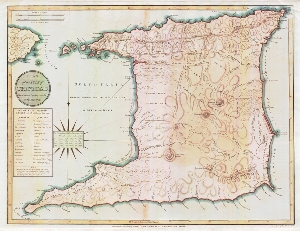News & Updates
Latest Acquisition for the Beinecke Collection
By Mark Tillson
October 6, 2015
The latest acquisition for the Beinecke Collection in Burke Library’s Special Collections originated in Trinidad in the year 1822. It is a large bound ledger book of about 350 pages with the simple title Prisons. Convictions Register. This incredible manuscript contains names of Slaves, Runaway Slaves, Free Blacks, “Black Mandingos,” Whites, Soldiers, American Refugees, etc., their Crimes, Dates of Incarceration, and Punishments, between the years 1822-1824.
This register was kept by the gaol clerk at the Royal Gaol (Prison) at Port-of-Spain, in Trinidad. The register includes 7 columns of information spread across double page entries with the following information for most entries: Dates of Commitment; Names; Description; By Whom Committed; Names of Owners (in the case of slaves); Offence; and Remarks (which sometimes are brief, but other times quite lengthy).
The volume is a fascinating look at life and society in Trinidad and the attitudes of the time on a variety of topics, such as crime, punishment, race relations, and the treatment of slaves. Slaves, including runaways, constituted a large proportion of prisoners in the gaol. The punishments included working the chain gang, floggings with the cat o’ nine tails, work on the dreaded treadmill, solitary confinement and banishment. There are several entries for slaves being sentenced for “practicing Obeism.” Obeah is the term used in the West Indies to refer to folk magic, sorcery, and religious practices developed among West African slaves, specifically of Igbo origin. The page pictured lists the name of a slave convicted of practicing Obeism and the punishment he was given for the offence.
One punishment listed often in the register is the “tread mill”. The “tread mill” was a form of manual labor punishment. These treadmills for punishment usually rotated around a horizontal axis, requiring the user to step upwards, like walking up an endless staircase. Those punished walked around the outside the wheel holding a horizontal handrail for stability. They remained in use until the second half of the 19th century.
Some other examples from the prison register:
- An example for a slave entry in the ledger is the case of Bob, a slave that was committed to the Royal Gaol on the 14th of Sept 1822. He was committed to the gaol by the chief of police on a charge of theft. Bob was owned by a Mr. Jones. Bob was sentenced to be the hangman at the gaol for ten years as punishment. He was however, paid a salary for doing the job and set free at the end of his sentence.
- An example of a soldier who was found guilty of murder was a man named “Cole,” who was committed by the “Commandant of Macurapo,” and was sentenced by the Chief Judge to work in a chain gang for four years and afterwards was banished from the island.
- On November 22, 1822, Prosper, a “Cabildo Negro,” was charged with having practiced Obeism – “upon a negro belonging to Mrs. Metiver named Charles by which the said Charles has been greatly affected in his health & intellect.” For this crime, Prosper was sentenced to be worked “one month in the Chain Gang.”
- William- alias Bill Johnson, an American refugee was committed to the Royal Gaol on 20 December 1823. His crime was breaking out of the prison. He was sentenced for “Two years and kept to hard labour and when not so employed in solitary confinement apart from the other prisoners and at the expiration of said term to be discharged.”
We are quite fortunate to have been able to obtain this volume for our Beinecke West Indies Collection. As with any of our treasures, we encourage everyone to stop by and see it in person if you are so inclined.


